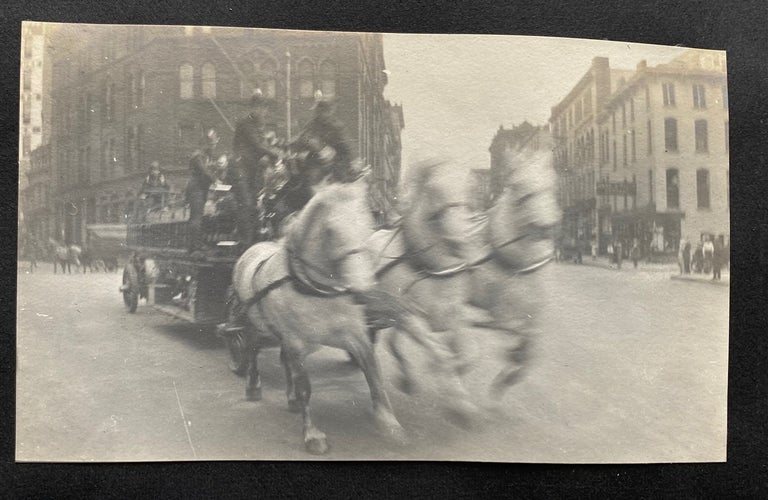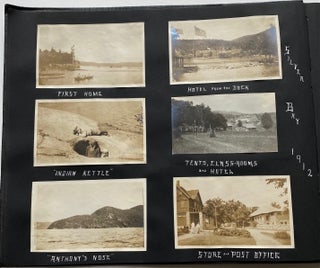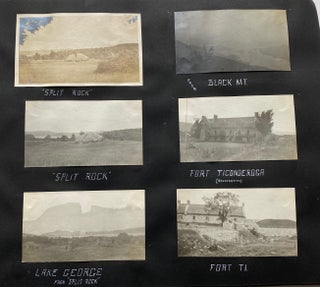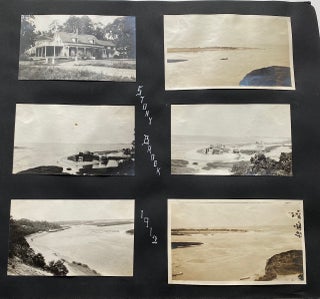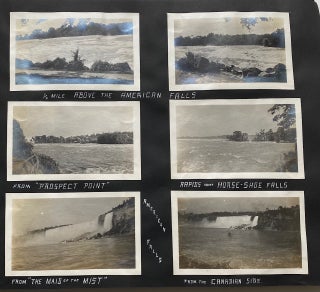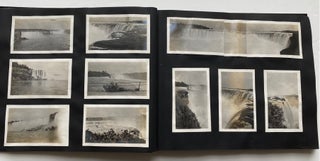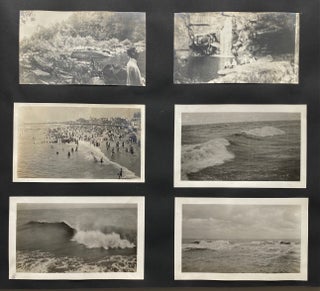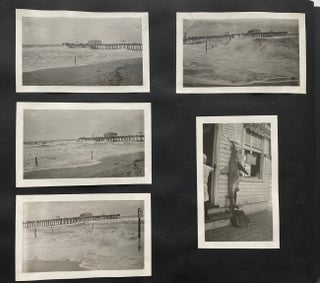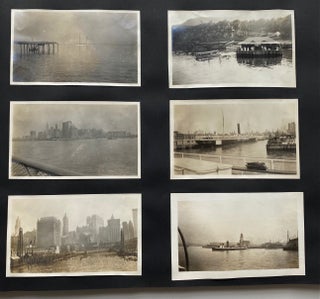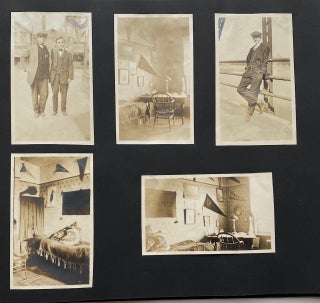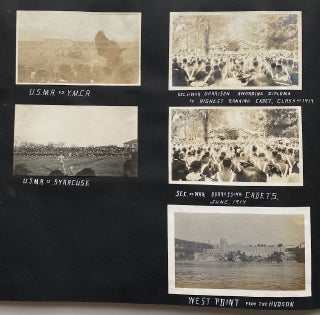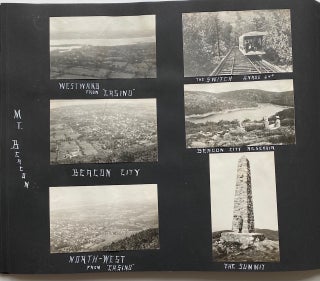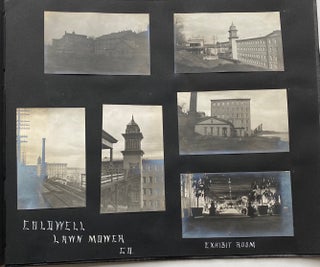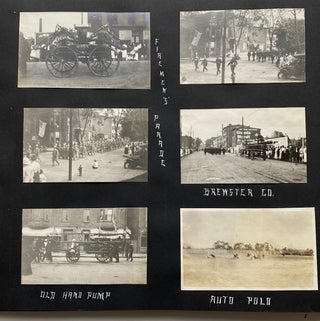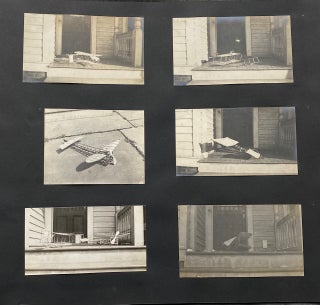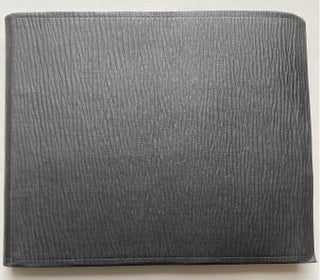1911-1914 HUDSON RIVER VALLEY PHOTO ALBUM NY
Item #522
This well-preserved, neatly-organized album presents a series of photos on various subjects in episodic fashion. The album measures 12 ½ x 10 ¼”, with a black, embossed, faux-leather cover with a book-binding, without rivets and tie. Both the album cover and the album pages of black construction paper are in very good condition.There are 45 double-sided pages, for a total of 90 single sides. Of these 90 single sides, 55 have photos. However, the empty pages are dispersed in bunches in the album, rather than coming at the end.The album begins with 20 pages of photos (40 sides) followed by 9 double-sided pages that are blank (18 sides), then 2 facing sides with photos, 2 facing sides without photos, 10 sides, what one might call the Hudson River section, with photos, 9 more sides without photos, and 9 sides concluding with photos, in a section that focuses on Newburgh, New York.
The album contains approximately 280 photos, of which most are mounted with a landscape orientation. The size of the photos varies little throughout the album: 4 ½” more-or-less in width (or height), 2 ½” to 2 3/4” in the opposite dimension. 93 of the photos have been printed without a white border; all the rest of the photos have such a border, though it varies from as much as a ¼” to 1/16”. Photos without the border tend to be a bit smaller in size than the others. The photos are all well glued-down. One photo on one page is missing. On some, but not all of the blank pages, one can find very faint white ink marks, almost like pinpricks, which indicate where a photo was to be mounted in the album. The precise regularity of the guidemarks leads on to believe they were made by machine, but again, they do not appear on every blank page, and one can see that, on pages with photos, the compiler did not always follow the guidemarks, as sometimes a photo needed to mounted in portrait orientation, and the guidemarks all indicate six photos per page, all mounted in landscape orientation. And indeed, this is the way most pages are organized.
The first part of the album, the most extensive, concerns tourist excursions and summer vacations, first a trip up to Lake George, where the participants stayed in a tent (probably a little better outfitted that the average Boy Scout tent, with plenty of amenities and a board floor, braided rugs and access to a bathhouse). Up the hill there was a grand resort hotel, where the family (if it was a family vacation; it may have been a large group of high school age boys) took their meals and mingled with the other guests. There is a lovely photo of a string of row boats being towed into position for a race on the lake, and another photo of two four-oared sculls, perhaps readying for another race. A side trip took them to Fort Ticonderoga, and another trip, perhaps on a different outing, took the group to Stony Brook, on Long Island Sound.
But the heart of the album is a section devoted to a trip to Niagara Falls. Niagara Falls photos seem to be obligatory in almost every album compiled east of the Mississippi and north of the Mason-Dixon line. These photos feel both more comprehensive and more skillfully done. There are six pages devoted to the Niagara Falls trip. The first page shows the river above the Falls, then three pages with seventeen photos (including two lovely homemade panoramas) of the falls themselves, and a final two pages, somewhat unusually, dedicated to the river below the falls, documenting both the river itself and the infrastructure lining it, including a photo taken inside a power-generating plant. What follows in this section are more tourist photos, bucolic nature scenes, a few photos taken in unidentified cities, a number of photos of waterfalls and the exterior of a cave. Towards the close of this section there are five pages of unidentified naval vessels, taken on the Hudson, one presumes. A few are taken in New York harbor.
Every photo album improves when it contains an iconic photograph. One such photo here is a photo of a fire engine, racing down a city street, perhaps in Newburgh being pulled by a matched team of three white horses, the horses a blur of motion, centered in the frame. The photo seems to depict a real moment of crisis, the response to a real fire, not a photo of a fire truck parading through town on the Fourth-of-July.
Blank pages follow, and then there is a page showing a young man’s dorm room, and the young man (who may in fact be our compiler), both posing rather seductively against a railing, and posing with a college chum. And then more blank pages.
The next section begins with a number of photos of what appears to be a college campus, and then focuses on a trip to West Point, with photographs of the citadel seen from the river, four photographs of cadets marching on parade, and then two photographs of a graduation ceremony, where Lindsey Miller Garrison, President Wilson’s Secretary of War, handed out the diplomas.
The final section presents more curiosities. There are photographs of male skaters racing on a frozen pond. There are two facing pages dedicated to photos of homemade model airplanes, all of a size and construction indicating they were meant to be flown and tested. Then there are photos of a parade in Newburgh, a photo of automobiles playing polo, and finally, three pages of more Newburgh scenes, with four lovely photos taken in the interior of Dubois’s Drug Store. Most interestingly, there is a page dedicated to the scenes of the Coldwell Lawn Mower Company, obviously a major Newburgh employer. And among these final pages there are also three pictures taken in a cemetery, featuring a large monument inscribed “Mapes.” Two different Mapes’s seem to provide a clue to the compiling of the album.
But first, a bit of background. Newburgh’s connection to lawnmower construction is an interesting one. Andrew Jackson Downing, the famous and influential writer, architect, and landscape designer, had been born in Newburgh. His theories led, eventually, to the popularity of the manicured lawns which now seem to cover the American landscape. Almost as a natural outgrowth of Downing’s theories, manicured lawns became an obsession. But homeowners needed practical and efficient lawnmowers to cut those lawns. Out of that need, from a small beginning, grew the Coldwell Lawnmower Company. And who should be the Treasurer of the Coldwell Lawnmower Company? Andrew Mapes. Perhaps Mr. Maps, or one of his children, produced the album.
A second candidate is W.H. Mapes, who was a well-known photographer in the Newburgh area. A search on the net produces images of a number of his photographs: cabinet cards of individuals, but also a number of photos of store exteriors. The four photos of the interior of Dubois’s Drug Store make one wonder if W.H. Mapes compiled the album for his own pleasure, using copies of some of the photos he had made professionally for clients. W.H. Mapes had two daughters, who could have been well-trained by their father and taken these photos. But the album seems like a young man’s album. Andrew Mapes, or one of his children (if he had children), presents a second candidate.
A bit more intensive research may help identify the likely candidate for the role of compiler/photographer.
Price: $295.00

